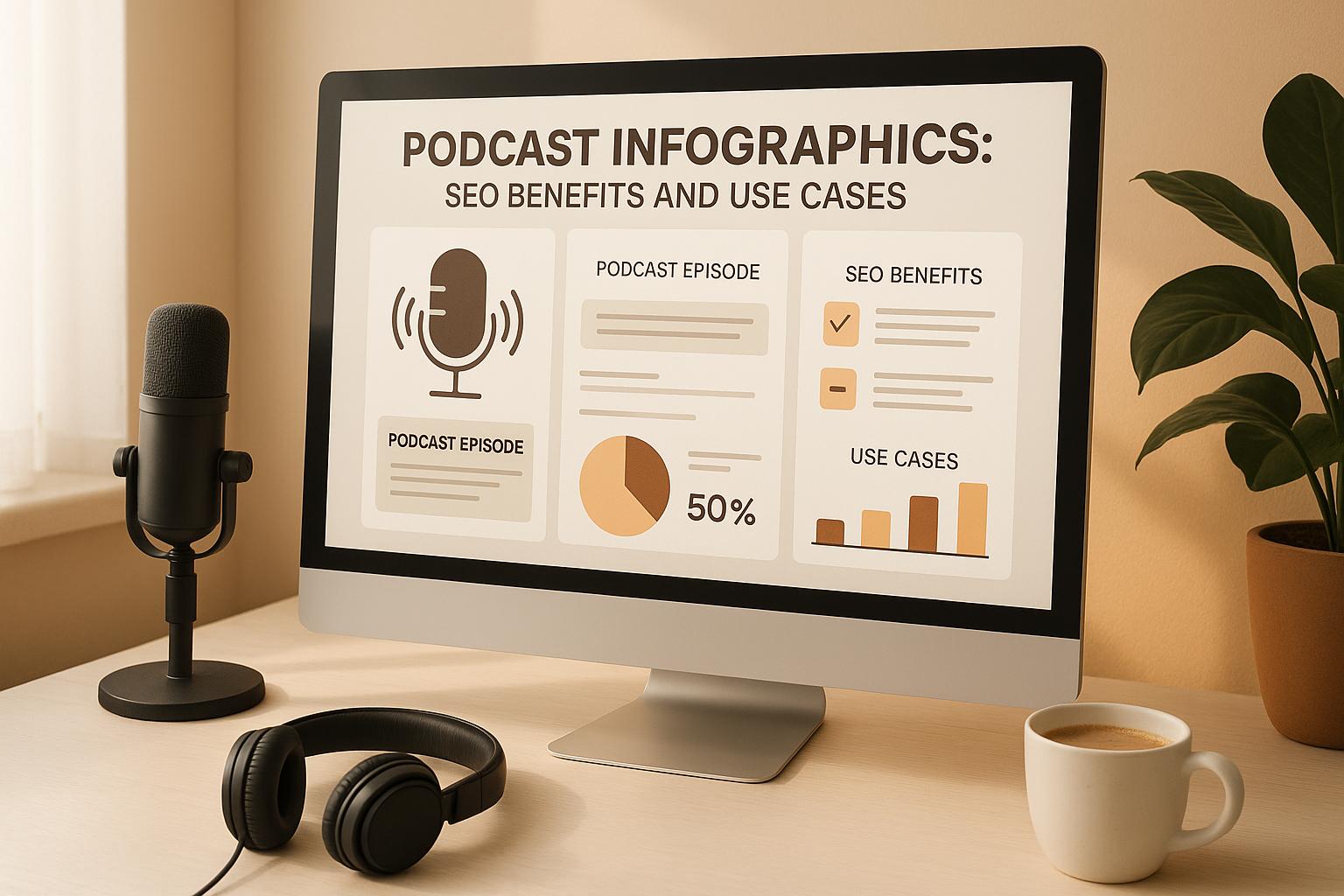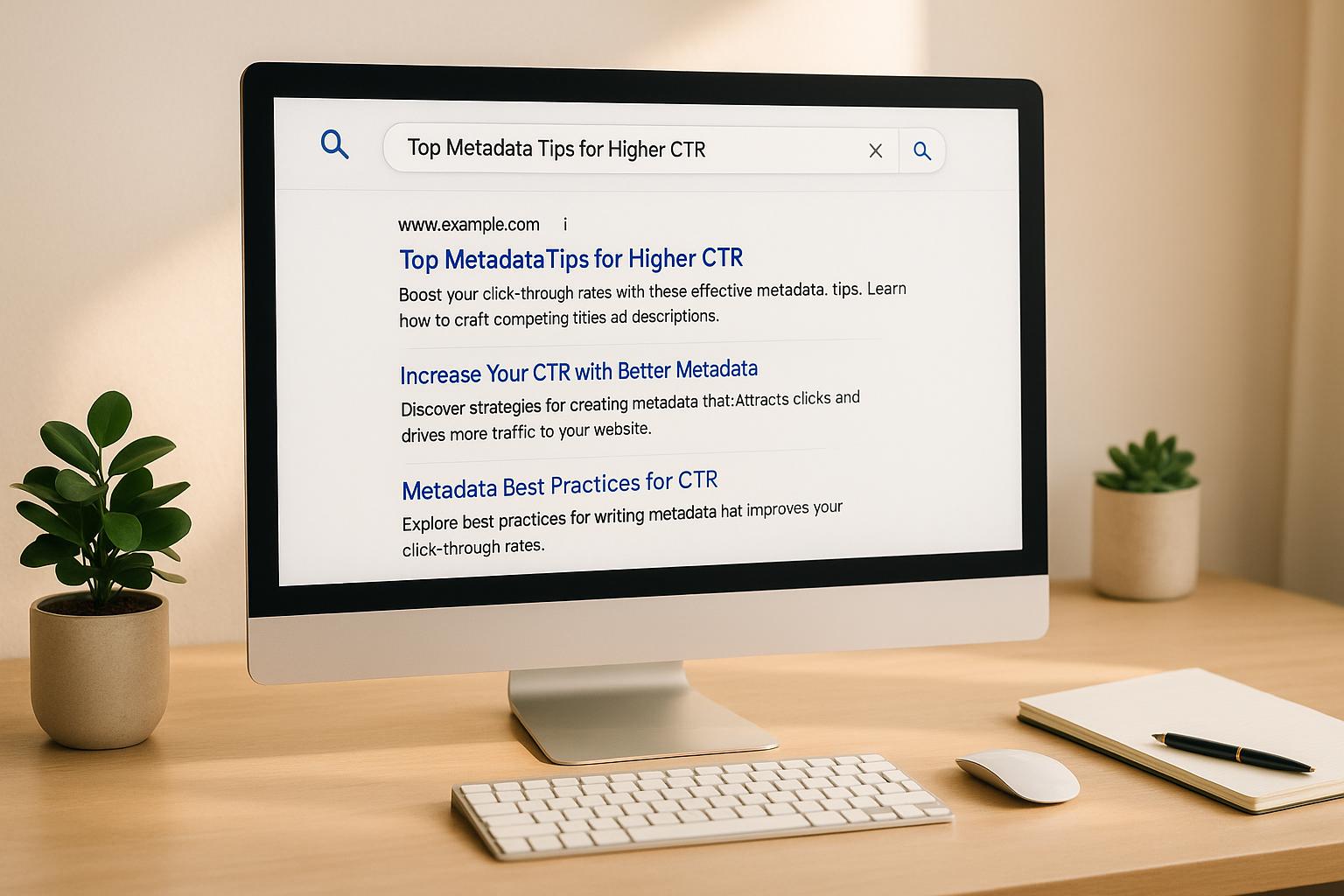Product metadata is critical for e-commerce SEO, shaping how your products appear in search results. Titles, descriptions, and other metadata elements must adhere to strict character and pixel limits to avoid truncation or rewriting by search engines like Google. Here's what you need to know:
- Meta Titles: Aim for 50–60 characters or around 580–600 pixels to ensure full visibility on desktop. Mobile displays may truncate at shorter lengths.
- Meta Descriptions: Keep these between 120–158 characters or 680–930 pixels, depending on device.
- Image Alt Text: Stay under 125 characters for accessibility and SEO.
- URL Slugs: Limit to 60 characters for better readability.
Exceeding these limits can result in truncated or rewritten metadata, potentially reducing click-through rates (CTR) and harming search visibility. Use tools to monitor pixel width and test how your content displays across devices.
Quick Metadata Reference Table
| Metadata Field | Character Limit | Pixel Limit | Notes |
|---|---|---|---|
| Meta Title | 50–60 | 580–600 (desktop) | Truncation starts at 525–535 pixels |
| Meta Description | 120–158 | 680–930 | Mobile displays ~120 characters |
| Image Alt Text | <125 | N/A | Focus on concise, descriptive text |
| URL Slug | <60 | N/A | Improves readability and SEO |
Stick to these limits to maintain control over your metadata and improve your search performance.
What's the Optimal Length for SEO Titles & Meta Descriptions? (SERP Snippet Preview Tool)
Meta Title Character and Pixel Limits
Meta titles act as the clickable headlines in search engine results, making them your first chance to grab a searcher's attention. Here's the catch: search engines don't just count characters - they measure the pixel width of your title to decide how much of it gets displayed.
Meta Title Length Guidelines
Google measures meta titles by pixel width, typically cutting them off at 525–535 pixels for desktop and around 650 pixels (or two lines) on mobile. To avoid truncation, aim for 50–60 characters (about 600 pixels) for desktop and no more than 50 characters (around 500 pixels) for mobile.
Keep in mind that not all characters take up the same space. Wider characters like "W" use more pixels than narrower ones like "i". So, even if your title is within the character limit, it could still get cut off if it includes too many wide letters.
"It is a common fallacy that Google has a character count limit for title tags and meta descriptions. In reality, there is a pixel width limit." – searchwilderness.com
Research shows that top-ranking pages often have titles between 42 and 46 characters. This indicates that concise titles tend to perform better and display properly across devices. Titles that exceed these limits risk being truncated, which can hide essential details.
Why Long Titles Are a Problem
If your meta title exceeds the pixel limit, search engines will truncate it with an ellipsis (...). This can obscure important details like product names, features, or calls-to-action, potentially lowering your click-through rate (CTR). When users can’t see the full title, they may skip your listing for one that’s clearer and more complete.
In some cases, search engines may rewrite overly long or poorly optimized titles, altering your intended message. This is especially problematic for e-commerce sites where specific product details are crucial for driving purchases. Since CTR is a key user signal for rankings, truncated titles can lead to fewer clicks, creating a cycle that negatively impacts your search visibility.
Tips for Writing Better Meta Titles
To optimize your meta titles, start by front-loading your most important keywords. Place your primary keyword at the beginning so it stays visible even if the title gets cut off.
"The title tag is one of the few ranking factors we can directly control, and I always aim to use it fully while avoiding spammy tactics like keyword stuffing." – Sara Taher, SEO Consultant
Use trigger words like "how", "best", "why", or "ultimate" to make your titles more engaging while staying within pixel limits. If you're selling products, include specific details like model numbers or sizes to stand out. For better readability, use title case instead of all caps and prefer dashes (–) over pipes (|). Ensure every page has a unique title to avoid repetition across your site.
Adding LSI (Latent Semantic Indexing) keywords can also help clarify your content's context. For example, if you're selling Apple products, including terms like "iPhone" or "MacBook" signals to search engines that you're referring to the tech brand, not the fruit.
Including a month and year in your meta titles can boost CTR by 5%. This can be particularly effective for seasonal items or time-sensitive offers, as long as it doesn’t push your title beyond the recommended pixel width.
Finally, monitor how your titles appear in search results. Use SEO tools to check pixel width and test your titles across devices to ensure they display consistently.
Next, we’ll dive into meta description limits to further refine your metadata strategy.
Meta Description Character and Pixel Limits
Meta descriptions, shown beneath your page title in search results, serve as a brief yet compelling pitch to attract clicks. These snippets aren’t just measured by character count but also by pixel width, so understanding both is key to ensuring they display correctly. Let’s dive into the ideal lengths to make your meta descriptions stand out.
Meta Description Length Requirements
To avoid truncation, aim for meta descriptions between 120 and 158 characters or 680–930 pixels. Keep in mind that wide characters (like “W” or “M”) take up more space, which could lead to cuts even within the character limit.
What Happens When Descriptions Are Too Long
Exceeding the pixel limit results in search engines cutting off your description with an ellipsis (...). This can reduce click-through rates. Even worse, if Google decides your description doesn’t align with the searcher’s intent, it might replace your carefully crafted text with content pulled from your page. This automated rewrite could leave out critical details like product features, pricing, or calls-to-action - elements that drive conversions.
Since click-through rates influence how Google ranks your page, poorly displayed descriptions can create a cycle where lower engagement hurts visibility. That’s why precision in crafting meta descriptions is so important.
Writing Better Meta Descriptions
A well-written meta description grabs attention and convinces users to click by highlighting your page’s value. Start with your primary keyword near the beginning - Google often bolds matching terms when they align with the search query. Use action-oriented language with clear calls-to-action like “discover,” “learn,” “get,” or “find” to encourage clicks.
Focus on answering user questions or solving their problems. For product pages, emphasize specific features, benefits, or unique selling points. If space allows, include a secondary keyword, but only if it doesn’t clutter the message. Each page should have a unique, branded description.
"A meta description tag generally informs and interests users with a short, relevant summary of what a particular page is about. They are like a pitch that convinces the user that the page is exactly what they're looking for." – Google Search Central
To ensure your descriptions stay within the recommended range, use a meta description length checker. If Google replaces your description, revise it to better match user intent and update it using the Google Search Console’s Inspect URL tool. While Google may tweak search results based on user behavior or query specifics, following these best practices gives your descriptions the best chance of appearing as you intended.
sbb-itb-5be333f
Other Product Metadata Character Limits
When it comes to metadata, it’s not just about meta titles and descriptions. Other metadata fields also play a pivotal role in shaping how your products appear to both users and search engines. Managing these character limits effectively can improve your visibility and click-through rates.
Product Names and Descriptions
Product names are the backbone of your metadata. They show up in search results, social shares, and product listings. While there’s no universal character limit, keeping names clear and concise ensures they display well across various platforms. For e-commerce sites, aim to balance brevity with enough descriptive detail, and naturally weave in key terms.
Metadata descriptions for products should highlight the most attractive features and benefits. Be mindful of platform-specific character limits to ensure your descriptions are impactful and visible.
Image Alt Text
Alt text for images serves two purposes: it helps visually impaired users by describing images and provides search engines with context about the visuals. Keeping alt text short and focused is essential for accessibility and SEO. Rachel Handley, Senior Content Writer at Semrush, emphasizes:
"Alt text should be concise - ideally under 125 characters - so users and screen readers can quickly read it."
Stick to under 125 characters, avoid redundant phrases like "image of", and only include keywords when they naturally fit the description . Matt Buxbaum, Writer and Growth Analyst at 1-800-D2C, adds:
"concise and short, without missing key elements of describing the image"
Structured Data Fields
Structured data markup helps search engines better understand your products, enhancing rich snippets and improving search visibility. Each structured data field comes with its own character guidelines. For instance, keep product names concise and descriptions tightly focused on key features. When it comes to URL slugs, aim for around 10 words to ensure readability across search results and social media. Fine-tuning these details across all metadata fields strengthens your overall SEO efforts.
Metadata Character Limit Reference Table
This table provides a quick reference for key metadata limits tailored to product pages.
Complete Limit Guidelines
Below is a detailed breakdown of recommended character and pixel limits for various metadata fields:
| Metadata Field | Character Limit | Pixel Limit (Desktop) | Pixel Limit (Mobile) | Notes |
|---|---|---|---|---|
| Meta Title | 50-60 characters | 580-600 pixels | Varies, may display fully | Truncation starts at 525-535 pixels |
| Meta Description | 150-160 characters | 920-1024 pixels | 680 pixels (~120 characters) | Google rewrites 60-70% of descriptions |
| Image Alt Text | Under 125 characters | N/A | N/A | Focus on accessibility and SEO |
| URL Slug | Under 60 characters | N/A | N/A | Improves user experience |
| H1 Tag | Under 70 characters | N/A | N/A | Main page heading |
| Image File Name | Under 50 characters | N/A | N/A | Keep descriptive but concise |
It's important to note that Google evaluates truncation based on pixel width rather than character count. Characters like "W" or "M" take up more space compared to narrower ones like "i" or "l", which means titles with wider characters may truncate earlier.
Why These Limits Matter
Sticking to these recommended limits can significantly improve your search performance. When your meta titles and descriptions display fully in search results, users get a complete picture of your content, which helps them decide to click. This full visibility often leads to higher click-through rates by removing ambiguity.
Additionally, staying within these limits allows you to maintain control over your search appearance. Exceeding the recommended lengths can result in search engines rewriting your titles and descriptions. By adhering to the guidelines, you reduce the risk of search engines altering your carefully crafted messaging.
These limits are particularly crucial for mobile users, as meta descriptions on mobile devices typically display around 120 characters. Ensuring your content fits within this range guarantees a consistent and clear presentation across devices.
Consequences of Exceeding Limits
Ignoring these guidelines can lead to several problems:
- Truncated Metadata: Titles longer than 600 pixels will be cut off in search results, leaving users with incomplete information. Similarly, truncated descriptions can reduce the clarity and appeal of your listing, making it less likely that users will click through.
- Loss of Control: When metadata is too lengthy, search engines may rewrite it. This can alter your intended message, potentially diluting your branding or missing key selling points.
In short, exceeding these limits can harm your search performance, reduce click-through rates, and give search engines more control over how your content appears. Staying within the recommended guidelines ensures your metadata is both user-friendly and optimized for search engines.
Summary
Following metadata limits is key to ensuring your products appear correctly in search results. Sticking to these recommendations helps your meta titles and descriptions display fully, avoiding truncation and giving users a clear understanding of what you offer. This clarity can improve click-through rates (CTR) and overall search performance.
This section pulls together best practices to help you maintain control over how your site appears in search results. A helpful reference table outlines typical character limits - 50–60 characters for meta titles and 150–160 characters for meta descriptions - along with guidelines for other metadata fields. These limits are based on how search engines format content across various devices. As John Mueller from Google notes:
"Meta Tags can affect the way that users see your site in the search results and whether or not they actually click through to your site".
Google takes into account pixels, context, and user behavior when displaying titles and descriptions. While Google may occasionally rewrite descriptions, adhering to the recommended limits helps ensure your messaging stays intact. Focus on including vital details within the first 155 characters of your meta description and create concise, search-intent-driven descriptions.
Use the reference table as a quick guide to check your compliance. Additionally, monitor your CTR and user behavior signals through Google Search Console to evaluate the effectiveness of your metadata. Consistently applying these practices can enhance both search visibility and user engagement on your product pages.
FAQs
Why should both character and pixel limits be considered for meta titles and descriptions?
When crafting meta titles and descriptions, it's crucial to account for both character limits and pixel dimensions. Why? Because search engines display these elements based on pixel width, not just the number of characters. For instance, meta titles typically fit within 600 pixels, which translates to about 50–60 characters. Meta descriptions, on the other hand, should stay within 430–923 pixels, roughly 150–160 characters, to avoid being cut off.
By balancing both pixel and character constraints, you ensure your metadata is fully visible in search results. This makes your content more engaging and increases the chances of users clicking on your link. It's all about optimizing visibility and click-through rates, ensuring the most important details are clear and accessible to potential visitors.
How can I stop Google from rewriting my meta descriptions?
To minimize the chances of Google altering your meta descriptions, focus on making them clear, relevant, and concise. Stick to the recommended length of 140-160 characters to avoid truncation and ensure they match user intent.
It’s also important to write meta descriptions that genuinely represent the content of the page and naturally incorporate target keywords. While following these guidelines increases the chances of your descriptions being displayed as-is, keep in mind that Google might still adjust them if it finds another snippet more relevant to the search query.
What are the best tools to check the pixel width of metadata and avoid truncation?
To make sure your metadata stays within the display limits set by search engines, you can rely on tools like Google Title & Description Tool, Title Tag & Meta Description Pixel Width Checker, and Screaming Frog SEO Spider. These tools are designed to measure the pixel width of your titles and descriptions, while also offering a preview of how they’ll look in search results.
By leveraging these tools, you can fine-tune your metadata, avoid truncation, and enhance how your content appears on search engine results pages.


